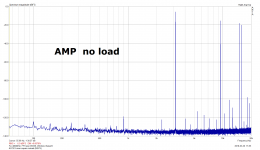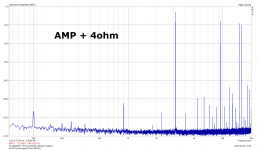thanks, Stuart was frequently mentioned inside the BT-thread as "no longer with us", so I presumed him to be sick or dead.
He got sick of it but I can assure you he is very much alive ;-)
Jan
> I hate those power chipamps, there is no way
> to cool them down reasonably and thermal coupling
> between output stage and input differential is a bad thing.
By the same token there is no other way (save lateral mosfets)
to ' reasonably ' thermally compensate an output stage.
> to cool them down reasonably and thermal coupling
> between output stage and input differential is a bad thing.
By the same token there is no other way (save lateral mosfets)
to ' reasonably ' thermally compensate an output stage.
well for a 40W/8R amp (which is what I needed for bi amping and domestic harmony), cooling the chip isn't an issue.
As for slew rate, if I have a 1MHz signal at the input at 2V RMS then I have a far bigger problem than clipping performance of the amplifier. If I needed 40W in the MHz region I certainly wouldn't use a chipamp 🙂. But I am more or less in control of the entire system.
As for slew rate, if I have a 1MHz signal at the input at 2V RMS then I have a far bigger problem than clipping performance of the amplifier. If I needed 40W in the MHz region I certainly wouldn't use a chipamp 🙂. But I am more or less in control of the entire system.
As for slew rate, if I have a 1MHz signal at the input at 2V RMS then I have a far bigger problem than clipping performance of the amplifier.
Then you have to add input filters to prevent the "far bigger problem". I know that 2V/1MHz input is unrealistic, but the amp should handle it.
Rising edge usually does not do this. I do not have much experience with LM3886, but I do have a lot of experience with OPA549. It is SR limited, but behaves nicely on rising and falling edges. If the protection trips, it is because of heat (dissipated power) and it needs some time to trip. I hate those power chipamps, there is no way to cool them down reasonably and thermal coupling between output stage and input differential is a bad thing. I also do not like amplifiers (of any kind) that misbehave at high input SR. Poor design, the designer should have used appropriate RC input filter in case he has troubles. Or just do it different way.
Thought the LM3886 uses some sort of V-A envelope to kick off the protection rather than purely thermal. That said, the complaints about the thermal coupling are largely eliminated in composites, as the control amp is very definitely decoupled thermally.
I'd also argue that this kind of "misbehavior" to this sort of stimulus is pretty benign! It's not like it launched into undamped oscillation, nor is it making any pretense about being a medium-frequency amplifier.
That said, the complaints about the thermal coupling are largely eliminated in composites, as the control amp is very definitely decoupled thermally.
There are numerous examples of far sub-ppm thermal coupling of output temperature to input offset, another retired problem.
In this case, I think Pavel's complaint isn't about offset but general performance of a "hot" IC versus one closer to room temperature. I could be wrong, though.
In this case, I think Pavel's complaint isn't about offset but general performance of a "hot" IC versus one closer to room temperature. I could be wrong, though.
Well some like it hot. 🙂 Seriously some even considerable rise above ambient is no problem for IC's. Fairchild had a heated diff-pair years ago that was regulated over the ambient by a margin. Thermocouple effects can be an issue at low/DC frequencies but most parameters are not a a problem, remember it's Kelvins 300K to 400K is not that much relatively.
Sine + square test
This post is especially for John, square 3150Hz + sine 15kHz test (bandlimited). 3 plots are shown:
- loopback of measuring system
- amplifier loaded with nothing (no load)
- amplifier loaded with 4ohm
Signal amplitude is about 21Vp.
This post is especially for John, square 3150Hz + sine 15kHz test (bandlimited). 3 plots are shown:
- loopback of measuring system
- amplifier loaded with nothing (no load)
- amplifier loaded with 4ohm
Signal amplitude is about 21Vp.
Attachments
Well some like it hot. 🙂 Seriously some even considerable rise above ambient is no problem for IC's.
When I tried a long-term 50% power test with power chipamps, they always switched-off themselves soon, regardless big size and low tempco of the heatsink used. It seems there is no effective way to dissipate heat from them below allowed temperature, protection shuts it down.
When I tried a long-term 50% power test with power chipamps, they always switched-off themselves soon, regardless big size and low tempco of the heatsink used. It seems there is no effective way to dissipate heat from them below allowed temperature, protection shuts it down.
That could certainly be the case, been through this with ADSL drivers the original AD815 had the right if not cost effective package.
Sine + square test
This post is especially for John, square 3150Hz + sine 15kHz test (bandlimited).
Sorry, 3180Hz + 15kHz.
> I hate those power chipamps, there is no way
> to cool them down reasonably and thermal coupling
> between output stage and input differential is a bad thing.
By the same token there is no other way (save lateral mosfets)
to ' reasonably ' thermally compensate an output stage.
I dont think any of them can run at the voltages they claim. My latest is 7293, and while it says 60v, the real limit is trying to land around 30v with tranny sag. Even at that, it can get hot and needs a pretty decent heatsink. 60v would probably be impossible to keep out of thermal protection for regular audiophile use.
So I agree and disagree. Btw it actually sounds good when it is too hot.
Well some like it hot. 🙂 Seriously some even considerable rise above ambient is no problem for IC's. Fairchild had a heated diff-pair years ago that was regulated over the ambient by a margin. Thermocouple effects can be an issue at low/DC frequencies but most parameters are not a a problem, remember it's Kelvins 300K to 400K is not that much relatively.
I once did an on-chip "oven" for a log/antilog circuit. 😀
I once did an on-chip "oven" for a log/antilog circuit. 😀
I know the PTAT resistors are a PITA.
I dont think any of them can run at the voltages they claim. My latest is 7293, and while it says 60v, the real limit is trying to land around 30v with tranny sag. Even at that, it can get hot and needs a pretty decent heatsink. 60v would probably be impossible to keep out of thermal protection for regular audiophile use.
So I agree and disagree. Btw it actually sounds good when it is too hot.
Yes. Different. I use TDA1521 @~ 34V
With minimal heatsink (since I usually play @ low level)
chip barely warms up.
To get same low xover notch with discreet, I must have
way higher idle (and temp)
However if I push chip it will heat up fast and alot and needs sink.
Discreet only slightly warms.
Caveat : discreet = lateral mosfets
For those who might be interested: Here is the definitive explanation of what PMA is concerned with, THERMAL FEEDBACK.
Unfortunately, the paper: Solomon 'The Monolithic OP AMP: A Tutorial Study' is too long to be put up here. It is in the Nov 1974, IEEE Journal of Solid State Circuits, and other sources such as National Semiconductor. Look it up.
Unfortunately, the paper: Solomon 'The Monolithic OP AMP: A Tutorial Study' is too long to be put up here. It is in the Nov 1974, IEEE Journal of Solid State Circuits, and other sources such as National Semiconductor. Look it up.
Last edited:
I dont think any of them can run at the voltages they claim.
You have to very carefully read the spec sheet and ignore the marketing claims.
- Status
- Not open for further replies.
- Home
- Member Areas
- The Lounge
- John Curl's Blowtorch preamplifier part III


